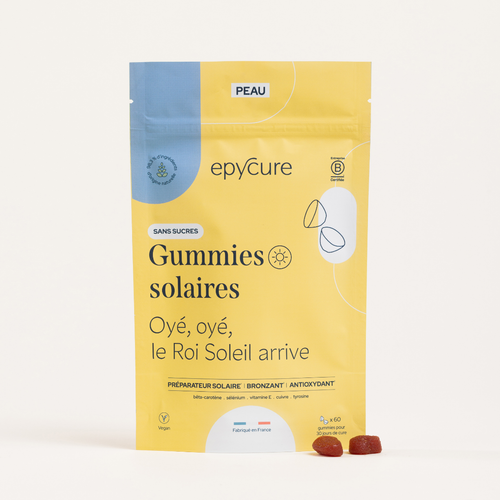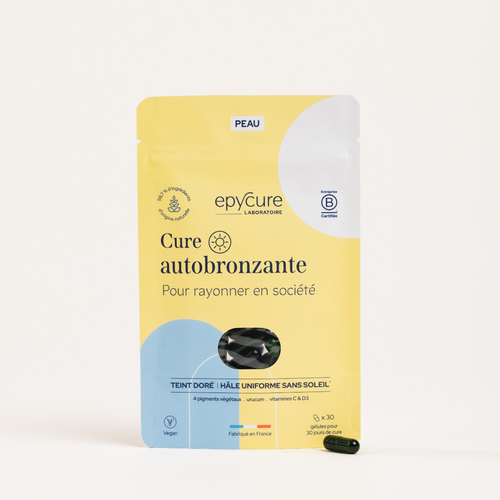With the return of summer and the intense heat, it's always tempting to expose yourself to the sun to show off a beautiful golden complexion . And yet, like every year, sunburn, redness and light eruption ruin our holidays...
We often ask ourselves this question when we go on vacation in the sun, but what about daily sun protection ? It is essential to know the basics to effectively protect yourself from UV rays while enjoying their benefits . So how can you enjoy the sunny days without exposing yourself to the dangers of UV rays?
Here we give you everything you need to know about UV rays and all our advice , basic but essential, to preserve your sun capital and enjoy a healthy and long-lasting tan all summer long !
What are UV rays?
UV rays are electromagnetic rays from the sun that are necessary for our bodies to synthesize vitamin D3 or boost our mood, for example. But they can also be responsible for significant skin lesions or damage ... UV rays are classified into three categories based on their ability to penetrate the skin.
- UVA : these rays penetrate the dermis slowly but deeply. They activate the melanin present in our skin, which causes it to tan gradually. But they are also responsible for photoaging , that is, the premature aging of the skin caused by overexposure to the sun (wrinkles, spots, loss of elasticity and firmness, etc.)
- UVB : UVB rays penetrate the epidermis fairly quickly but do not reach the dermis. They allow the synthesis of vitamin D and are responsible for a lasting tan thanks to the formation of new melanin in the skin 2 to 3 days after exposure. They are nevertheless responsible for sunburn , which is nothing more or less than an inflammatory reaction of the skin in response to excessive exposure, which is often accompanied by skin dehydration, peeling and sometimes blisters .
- UVC : Unlike the other two, UVC rays are completely absorbed by the ozone layer and do not reach the Earth's surface. These are the most harmful UV rays ; without the ozone layer, life on Earth would be impossible.
And what is the UV index?
We often hear about the “UV index,” a measure of the intensity of UV radiation that should obviously not be confused with the sun protection factors listed on the packaging of these products. The higher it is, the greater the potential for skin and eye damage , and the shorter the time it will take for this exposure to be considered dangerous. The UV index reaches its peak around the summer solstice in June . And it is of course at noon, when the sun is highest in the sky, that the UV index is at its highest.
Our advice to apply as soon as the good weather arrives
Don't skimp on sunscreen
Sunscreen is a tan's best friend . It protects you from the risk of skin cancer and actively fights against skin aging. So, for all your outdoor activities, get into the habit of protecting yourself! No matter your skin type. This will allow you to avoid all the unpleasantness that regularly accompanies overexposure (sunburn, peeling skin, spots, etc.) so that the sun remains, above all, a pleasure.
Finally, let's remember that sunscreen can be our ally all year round, not just as summer approaches. Opt for applying a city sunscreen in your daily morning routine that will protect you from UVA rays all day long. And complete this routine with a beach sunscreen when the good weather arrives that will effectively protect you from UV rays while resisting your swimming, but be careful, don't forget to reapply this approximately every 2 hours, or even 1 hour , until the last day of vacation!
Beware of preconceived ideas: Contrary to what many people may think, protecting yourself does not prevent you from tanning . On the contrary, you will take on color more slowly, but in a healthier and more lasting way. Indeed, sunscreen will play the same filtering role as melanin by absorbing some of the UV rays . Tanning with sunscreen thus helps protect the epidermis from the risks associated with the sun, while allowing the skin to color.
We choose the right protection index
SPF (Sun Protection Factor) is the index that measures the degree of protection of the product against UVA and UVB rays . A good SPF for your skin should be chosen according to your skin type and the intensity of the sun you face. When in doubt, it is always better to opt for high protection .
- SPF 50+ : This factor blocks 99% of UV rays . If you have light, sensitive, and reactive skin that burns easily and therefore needs extra protection, this factor is for you.
- Index 30 and 50 : These indexes will block 96% and 98% of UV rays respectively. This difference may seem small but it makes all the difference. They are recommended for dark skin that tans quickly , with a low risk of sunburn . Always opt for maximum protection.
- Index 10 : it will only block 90% of UV rays , so we obviously do not recommend using this index alone. Only very dark skin that hardly ever gets sunburned should use it occasionally.
How to choose your sunscreen?
- Not all UV protectors are created equal : Choose products with a good SPF based on photostable UVA and UVB sunscreens . There are two types of UV filters: so-called “natural” mineral filters and chemical filters.
Mineral filters are good candidates because they have good tolerance , however, they only actually protect one type of UV and have difficulty reaching SPF50 unlike chemical filters which contribute to very broad anti-UV protection .
For optimal protection, it is best to opt for a sunscreen product based on chemical UV filters only or combined with mineral filters .
- Waterproof : very important. We never know if we can plan a little swim during the day. Just in case, adopt a waterproof sunscreen that will retain 70% of its effectiveness after swimming .
- Environmentally and ocean-friendly : Sunscreens can contain substances that are harmful to the environment. Adopting environmentally friendly products is not only about protecting our oceans , but also about protecting ourselves, by protecting the ozone layer .
- In the form of oils or milk : The choice is yours, the texture will not affect its protection from the sun . Avoid at all costs monoi, or any other oils that promise a quick tan without sun protection, these products only burn the skin very quickly and expose you to high risks of developing melanomas and carcinomas.
We avoid making crepes during the hottest hours
The sun is most harmful between 12 p.m. and 4 p.m. Furthermore, it is at its highest point at 12 p.m., which means that this is when the sun is most dangerous because it is less well filtered. Applying a good sunscreen obviously does not protect us from all dangers, so we moderate our exposure at these times, otherwise we risk sunburn or heatstroke. Don't neglect the parasol either, which can help you thanks to its shade!
We adopt a post-tan routine
After an afternoon in the sun, your skin needs to be pampered . Adopting an after-sun routine will help you prolong your tan while keeping your skin radiant and hydrated. In your shower, opt for exfoliating your skin with a gentle scrub to eliminate dead cells accumulated during the day. This optimal scrub will prepare your skin for good hydration with the application of an after-sun cream all over your body and a moisturizer on your face . By taking care of your skin's hydration, you will help it limit its aging while providing tan-prolonging effects.
We protect our eyes as well as our skin
Wrinkling of the eyelids and retraction of the pupils are physiological reactions that unfortunately are not enough to protect the eyes from the sun, so we opt for the perfect vacationer's equipment: a hat and sunglasses! Sunglasses help supplement the natural filtration provided by the eye and thus preserve eye health, so they should not be neglected. Opt for a pair of sunglasses with polarized lenses chosen by your optician . Sunglasses found in small boutiques and clothing stores do not protect you enough from the sun, if at all.
Please note that overexposure of the eyes to UV rays can have serious consequences : repeated conjunctivitis, early cataracts or even ophthalmia, a burn of the cornea caused by UV rays.
We avoid sudden exposures
Opt for gradual and limited sunbathing , your tan will be even more successful and long-lasting! Indeed, basking in the sun for hours from one day to the next is really not ideal for the skin and is especially not useful for tanning faster since the activation of melanin takes place gradually over 2 to 3 days. The risk is above all to get a severe sunburn and not be able to expose yourself for a few days...
To help your skin gradually get used to UV rays, choose short sessions in the sun that are spaced out enough to avoid damaging it. You can also gently prepare your skin by opting for food supplements rich in antioxidants and carotenoids , such as beta-carotene.
We are now opting for sun supplements
Our solar gummies
To help you protect your skin and prepare your tan from the inside out, you can turn to our sugar-free Sun Gummies , small chewable gummies with a delicious cherry flavor that accelerate tanning and will strengthen the skin's self-protection . Rich in beta-carotene, selenium, zinc, vitamins C and E, it is your new natural ally for healthy tanned skin. To optimize its effects, it is recommended to start the treatment at least three weeks before sun exposure, to continue it throughout exposure and then two to three weeks after exposure .
Our self-tanning treatment
Do you want to look tanned all year round without sun exposure ? Say no more! Choose our Self-Tanning Treatment for a tanned and even complexion without sun exposure. Formulated with plant pigments, urucum, copper and vitamins E and D3, say goodbye to unsightly orange traces of self-tanning creams that show the passage of the product on the skin. To be taken throughout the year , you will be able to see the first results after 1 month of treatment and 3 months for optimal results on the tan of the skin that will last over time!
To learn everything about tanning and our tips for applying it this summer, download our tanning booklet by clicking here.





